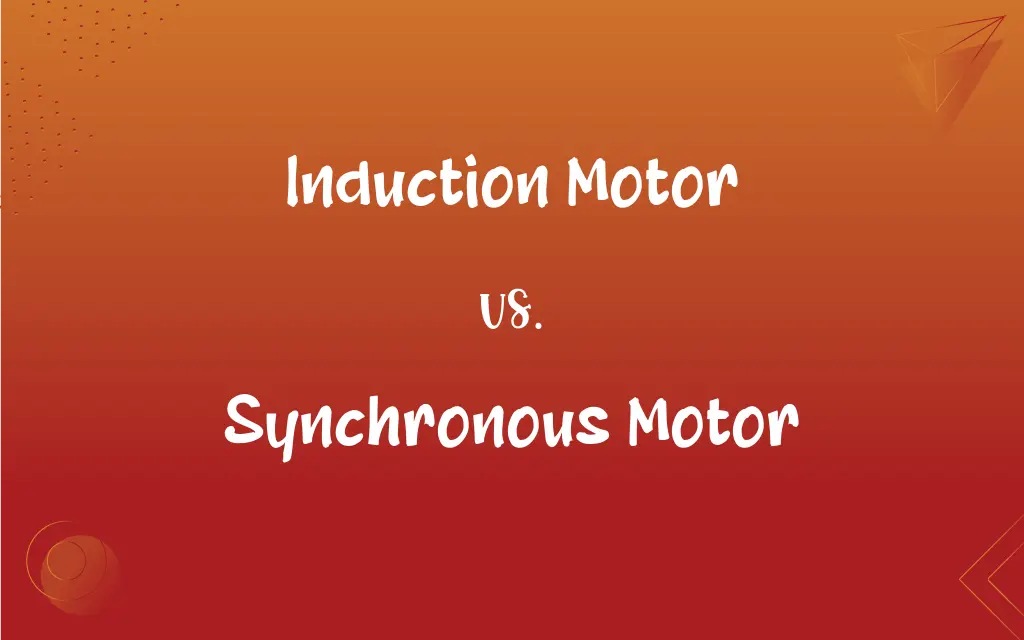Induction Motor vs. Synchronous Motor: What's the Difference?
Edited by Aimie Carlson || By Harlon Moss || Updated on October 17, 2023
Induction motors use slip to operate and are self-starting, while synchronous motors run at a constant speed determined by the power supply frequency.

Key Differences
The induction motor and the synchronous motor are two primary types of AC motors, each possessing unique characteristics. Induction motors, often termed as asynchronous motors, are the more commonly used of the two in everyday applications.
Induction motors work based on the principle of electromagnetic induction. When power is supplied, a rotating magnetic field is generated, inducing a current in the rotor. This induced current generates its own magnetic field, which interacts with the original field to produce torque. Interestingly, induction motors always run at a speed less than the supply frequency. On the other hand, synchronous motors, as the name suggests, operate in sync with the supply current's frequency.
One standout feature of induction motors is their self-starting capability. They don't require any additional starting mechanisms. In contrast, synchronous motors are not self-starting and need external means, like a damper winding, to start.
In terms of efficiency, synchronous motors generally are more efficient than induction motors for larger applications. Moreover, synchronous motors can operate at leading, lagging, or unity power factor, giving them a distinct advantage in power factor correction. In contrast, induction motors usually operate at a lagging power factor.
While induction motors are more prevalent in household appliances due to their simplicity and ruggedness, synchronous motors are chosen for high precision tasks and where speed constancy is crucial.
ADVERTISEMENT
Comparison Chart
Operating Principle
Electromagnetic Induction
Synchronous with supply frequency
Speed
Always less than supply frequency
Constant, equal to supply frequency
Self-Starting
Yes
No
Power Factor
Typically lagging
Can be leading, lagging, or unity
Common Usage
Household appliances, general applications
Precise tasks, power factor correction, large applications
ADVERTISEMENT
Induction Motor and Synchronous Motor Definitions
Induction Motor
A machine that transforms electrical energy into mechanical energy using induction principles.
The induction motor in the washing machine ensures efficient spin cycles.
Synchronous Motor
A motor that operates in sync with the supply current's frequency.
High precision machinery often employs a synchronous motor.
Induction Motor
An asynchronous motor relying on a rotating magnetic field.
The induction motor is favored for its ruggedness in many industrial applications.
Synchronous Motor
A motor whose rotor turns at the same rate as the rotating magnetic field.
In applications requiring steady speed, a synchronous motor is ideal.
Induction Motor
An AC motor where torque is produced by electromagnetic induction.
The fan in our living room uses an induction motor for its operation.
Synchronous Motor
A machine that provides constant speed and can correct power factor in circuits.
The factory utilizes synchronous motors for power factor correction.
Induction Motor
A motor where the rotor's speed is not synchronous with the supply current.
The pump in our backyard operates with an induction motor.
Synchronous Motor
An AC motor that doesn't change speed based on the load.
The synchronous motor ensures the clock runs at a consistent pace.
Induction Motor
A self-starting motor that runs at a speed less than the supply frequency.
Many household appliances prefer induction motors for their simplicity.
Synchronous Motor
A motor requiring an external means for starting.
Starting a synchronous motor might require an additional mechanism.
FAQs
What's the primary principle behind the induction motor?
The induction motor operates based on electromagnetic induction.
Do induction motors require starters?
Induction motors are self-starting and don't need external starters.
How does a synchronous motor maintain its speed?
It runs in sync with the power supply's frequency.
Why might a synchronous motor be preferred in industrial settings?
Its ability to provide constant speed and correct power factor makes it valuable.
Are synchronous motors suitable for power factor correction?
Yes, synchronous motors can operate at varying power factors, aiding in correction.
Can synchronous motors operate without a DC supply?
Some designs require a DC supply for the excitation, but others use alternative methods.
How do I increase the efficiency of my induction motor?
Regular maintenance, balanced voltage, and proper sizing can enhance efficiency.
How can synchronous motors aid in power stability?
By running at leading power factors, they can support grid stability.
Which motor is better for high-torque applications?
Synchronous motors can provide higher torque at low speeds.
What causes the "slip" in induction motors?
The difference between rotor speed and supply frequency results in slip.
Can synchronous motors run at variable speeds?
Typically, they run at a constant speed determined by the supply frequency.
Can induction motors operate at different speeds?
Yes, with variable frequency drives, their speed can be varied.
Are there noise differences between the two motors?
Induction motors might produce more noise due to slip, while synchronous motors can be quieter at constant speeds.
Which motor is more common in household appliances?
Induction motors are more prevalent in household devices.
Do synchronous motors need regular maintenance?
While they require initial setup, their maintenance is comparable to induction motors.
Why isn't a synchronous motor self-starting?
Its rotor speed needs to match the supply frequency, requiring external means to start.
Which motor type is generally more efficient in large applications?
Synchronous motors tend to be more efficient for larger tasks.
Why are induction motors considered rugged?
Their simple design and fewer components make them durable.
What's the role of the rotor in induction motors?
The rotor conducts induced currents, producing its magnetic field.
How do external factors affect induction motor performance?
Factors like voltage imbalance can affect performance and lifespan.
About Author
Written by
Harlon MossHarlon is a seasoned quality moderator and accomplished content writer for Difference Wiki. An alumnus of the prestigious University of California, he earned his degree in Computer Science. Leveraging his academic background, Harlon brings a meticulous and informed perspective to his work, ensuring content accuracy and excellence.
Edited by
Aimie CarlsonAimie Carlson, holding a master's degree in English literature, is a fervent English language enthusiast. She lends her writing talents to Difference Wiki, a prominent website that specializes in comparisons, offering readers insightful analyses that both captivate and inform.































































